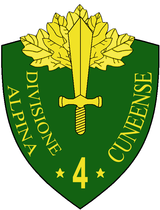|
4th Alpine Division "Cuneense"
The 4th Alpine Division "Cuneense" (Italian: 4ª Divisione alpina "Cuneense") was a division of the Royal Italian Army during World War II, which specialized in mountain warfare. The headquarters of the division was in the city of Cuneo, and the majority of its Alpini soldiers were drafted from the surrounding Province of Cuneo - hence the division's name "Cuneense". The division participated in all Italian World War II campaigns with the exception of the North African Campaign. The division was annihilated during Operation Little Saturn by Soviet forces in January 1943. HistoryThe division's lineage begins on 19 October 1933 when the 1st Alpini Regiment in Mondovì and 2nd Alpini Regiment in Cuneo left the 1st Alpine Division "Taurinense" and entered the newly raised IV Alpine Brigade in Cuneo. On 1 January 1934 the newly formed 4th Mountain Artillery Regiment in Cuneo joined the brigade. On 27 October 1934 the brigade changed its name to IV Superior Alpine Command, which received the name Cuneense in December of the same year (Italian: IV Comando Superiore Alpino "Cuneense"). On 31 October 1935 the IV Superior Alpine Command "Cuneense" was reorganized as 4th Alpine Division "Cuneense" with the 1st and 2nd Alpini regiments and the 4th Alpine Artillery Regiment "Cuneense". On 25 December 1935 the Cuneense temporarily transferred its Alpini battalions "Pieve di Teco" and "Saluzzo" and its 11th Mountain Artillery Battery to the 5th Alpine Division "Pusteria" for the Second Italo-Ethiopian War.[1] World War IIInvasion of FranceThe division participated in the Italian invasion of France in June 1940. On 22 June it entered French territory in the Chabriere and Mary valleys.[1][2] Greco-Italian WarIn December 1940 the division was sent as reinforcements to Albania for the Greco-Italian War. Between 15-17 December 1940 the division's units entered the front in the upper Devoll valley. On 18 March 1941 the division was taken out of the front and sent to Berat. At the end of March the division deployed to the Yugoslav-Albanian border for the upcoming Invasion of Yugoslavia. On 10 April the division crossed the border and advanced to Debar in Macedonia. After the war's conclusion the division returned to Italy in May 1941.[1][2] Soviet UnionThe Cuneense was one of the ten Italian divisions of the Italian Army in Russia, which fought on the Eastern Front. In July 1942 the division, together with the 2nd Alpine Division "Tridentina" and the 3rd Alpine Division "Julia" formed the Alpine Army Corps, which was transferred to Eastern Ukraine. In July 1942 the division arrived in Izium from where it marched eastwards to Millerovo and then onward to the Don river. The Italian units covered part of the left flank of the German 6th Army, which spearheaded the German summer offensive of 1942 into the city of Stalingrad.[1] On 12 December 1942 the Red Army's Operation Little Saturn commenced, which in its first stage attacked and encircled the Italian Army in Russia's II Army Corps and XXXV Army Corps. On 13 January 1943, the Red Army launched the second stage of Operation Little Saturn: four armies of General Filipp Golikov's Voronezh Front attacked, encircled, and destroyed the Hungarian Second Army near Svoboda on the Don to the northwest of the Alpine Army Corps and pushed back the remaining units of the German XXIV Army Corps on the Alpine Army Corps' left flank, thus encircling the Alpine Army Corps.[3] On the evening of 17 January, the Alpine Army Corps commander, General Gabriele Nasci, ordered a full retreat. At this point only the Tridentina division was still capable of conducting effective combat operations. The 40,000-strong mass of stragglers — Alpini and Italians from other commands, plus German and Hungarian Hussars — formed two columns that followed the Tridentina division which, supported by a handful of German armored vehicles, led the way westwards to the Axis lines. As the Soviets had already occupied every village bitter battles had to be fought to clear the way. On the morning of 28 January the Cuneense had walked 200 km, fought 20 battles, lost 80% of its men and spent 11 nights camped out in the middle of the Russian Steppe. Temperatures during the nights were between -30 °C and -40 °C. On 28 January the last remnants of the division were annihilated by Cossack forces. The last survivors of the 1st Alpini regiment burned the regiment's flag to prevent it from falling into enemy hands. The Cuneense then ceased to exist.[3] CasualtiesOn 11 February 1943 the count of the survivors gave the following result:[4]
In total 1,607 men of the division's total of 17,460 survived Operation Little Saturn. Return to ItalyThe remnants of the division were repatriated in March 1943 and the division was reformed on 1 May 1943 in Bolzano with troops of the 1st Alpini "Valley" Group of the 6th Alpine Division "Alpi Graie" and with the 104th Marching Alpini Regiment of the 8th Marching Division.[2] After the announcement of the Armistice of Cassibile on 8 September 1943 the invading German forces disbanded the division.[1] OrganizationIn late 1942 the division consisted of the following units:[5][6][1][2]
The division strength was 573 officers and 16,887 NCOs and soldiers for a total strength of 17,460 men. The division also had 176 horses, 4,698 mules and 584 transport vehicles at its disposal. [1] Archived 9 May 2008 at the Wayback Machine Military honorsFor their conduct during the Italian campaign in the Soviet Union the President of Italy awarded on 31 December 1947 to the three regiments of the 4th Alpine Division "Cuneense" Italy's highest military honor, the Gold Medal of Military Valor.
Commanding officersThe division's commanding officers were:[1][2]
References
Sources
|
||||||||||||||||||||||||||||||
Portal di Ensiklopedia Dunia
